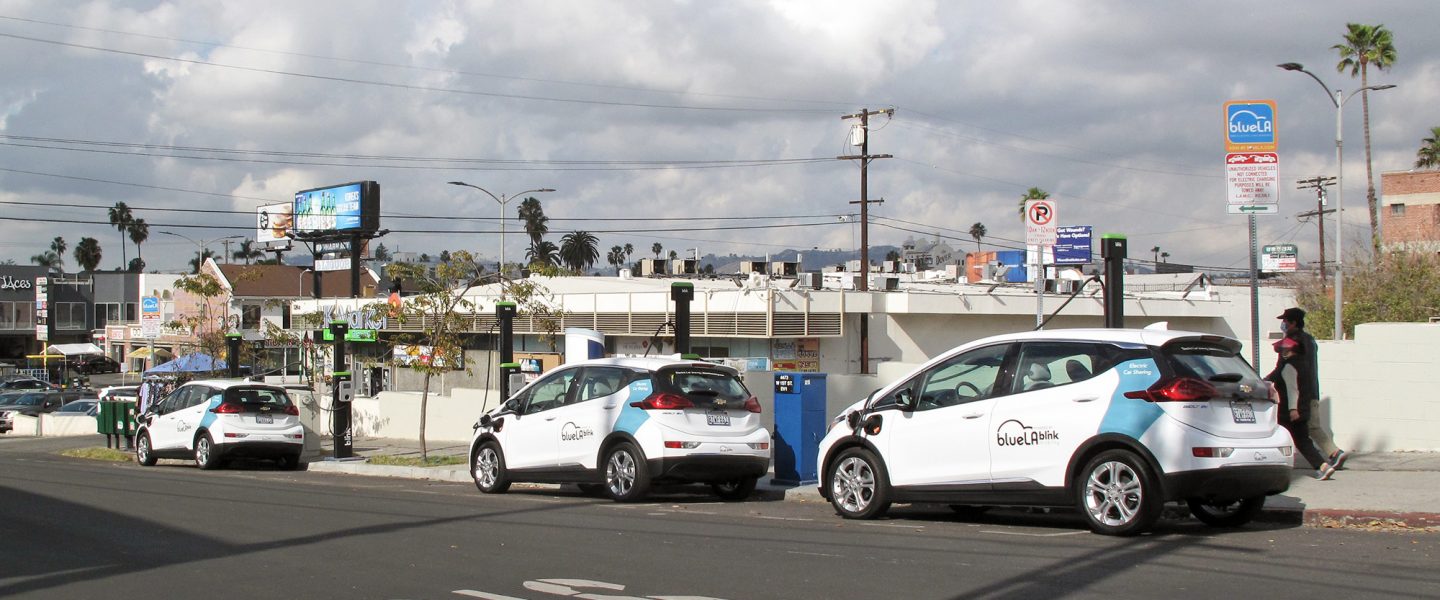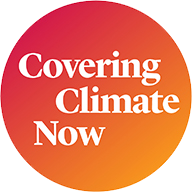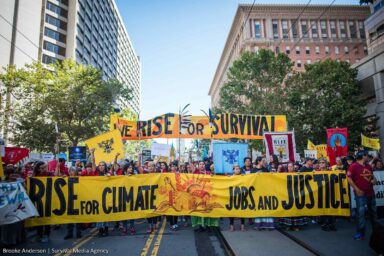An uptick in clean vehicles has improved air quality in wealthier communities over marginalized communities in California, a new study finds.
|
Listen To This Story
|
California has some of the most aggressive climate laws in the country, including its Clean Vehicle Rebate Project, which incentivizes the purchase of electric vehicles (EVs), plug-in hybrids, and fuel-cell vehicles. The state has issued more than half a million clean vehicle rebates since 2010. A new study shows that the program is having a mixed effect on air quality.
“I want to emphasize that California Clean Vehicle Rebate Project has had many successes,” said environmental sociologist Jaye Mejía-Duwan, a doctoral candidate at the University of California, Berkeley. The program supports decarbonizing transportation, a sector that emits nearly 40 percent of the state’s carbon dioxide emissions. Individuals who purchase one of the vehicles from the program’s approved list receive a check between $1,000 and $7,500, depending on income.
Air quality has improved in well-off communities as more clean cars hit the pavement between 2010 and 2021. But in marginalized neighborhoods? Not so much. These communities saw fewer reductions in nitrous oxide, sulfur dioxide, and soot-like particles (PM2.5) from car exhaust than well-off neighborhoods.
The study is the first to compare pollution in more granular census tracts than broader county-wide swaths — a more accurate way to tease out air quality differences among neighborhoods. The researchers considered air pollution between 2010 and 2021 on the basis of public listings of rebates and emission models.
Collecting the Pieces
“One of the great things about California is that it reports such high-quality and publicly available data,” Mejía-Duwan said. The Clean Vehicle Rebate Project posts the make and model, vehicle type, and census tract of every rebate granted.
Plug-in vehicles are “only as clean as the underlying electric grid from which their electricity is sourced.”
Mejía-Duwan and their colleagues determined the change in local vehicle emissions using the state’s Emission Factor (EMFAC) model, which estimates how many air pollutants different types of vehicles emit. They applied those emission rates to vehicles tallied by the rebate project in each census tract. The researchers accounted for car movement by adjusting the emissions of surrounding census tracts within a 15-kilometer (~9-mile) radius (the typical length of a California metro commute).
In the second half of the analysis, the researchers turned to the EPA’s electricity dispatch model AVERT (avoided emissions and generation tool) to calculate the change in emissions from power plants due to EV charging.
Plug-in vehicles are “only as clean as the underlying electric grid from which their electricity is sourced,” said Mejía-Duwan.
The researchers calculated the change in annual pollutants at each of the state’s 231 electrical generating units as more plug-ins came online. They assumed that people living within 5–20 kilometers (3–12 miles) of power plants were exposed to emissions.
The study showed that carbon dioxide, nitrous oxide, and sulfur dioxide emissions decreased statewide between 2010 and 2021. But the drop was uneven.

Annual nitrous oxide and sulfur dioxide emissions in marginalized communities fell by a third of what well-off communities experienced. Surprisingly, statewide primary PM2.5 emissions increased even as more cars went electric. (Heavier EVs causing more tire and road wear contribute to PM2.5.) Still, wealthy neighborhoods were more likely to see decreases or stagnation of PM2.5 rather than increases.
Sociologist Manuel Pastor at the University of Southern California in Los Angeles, who did not participate in the research, called the work “well done.” He praised the mixture of modeling and varied energy sources.
“The authors make the important contribution of considering air pollutant emissions from the power plants that generate the electricity to power electric vehicles,” said Lara Cushing at the University of California, Los Angeles, who was not involved in the study.
The Sources of Inequalities
Addressing historical inequalities and ensuring an equitable transition to low-emission technologies have been a “key priority” for California, said Dave Clegern from the California Air Resources Board, the state agency funding the rebate program. Clegern said the focus of the rebate program has evolved from kickstarting an emerging technology in 2010 to a program actively addressing accessibility for the technology.
Marginalized communities “receive substantially fewer rebates than their undisadvantaged counterparts.”
Although California seeks to lift the state’s disadvantaged communities, rather than leaving them behind, “so far, the incentive program has not achieved that,” said sustainable transportation researcher Dana Rowangould at the University of Vermont, who was not involved in the study.
Mejía-Duwan pointed out structural challenges that exclude marginalized communities from benefiting from EVs. The ability to purchase electric vehicles is highly dependent on income, and marginalized communities “receive substantially fewer rebates than their undisadvantaged counterparts,” they said. Though a few models, such as the compact Nissan Leaf, start at or around $30,000, the average electric car price was $61,000 in 2023, according to Kelly Blue Book.
Furthermore, EVs increase the load on power plants, which are disproportionately located in marginalized communities.
Environmental injustice, the disproportionate exposure of racial and ethnic minorities and low-income groups to pollutants, hazardous waste, and other environmental hazards, is a “severe problem in both the state of California and the nation,” Pastor said. “These results will doubtlessly cause the state to take an extra look and make sure that it is addressing climate and equity goals most effectively.”
Starting in 2016, the state has adjusted the rebate program to shift resources toward low- and moderate-income groups, Clegern said. The state offers higher rebates to people with incomes less than or equal to 400 percent of the federal poverty level and now excludes high-earning residents from receiving rebates. Clegern pointed to a new rebate benefit coming in July for $2,000 toward charging support in disadvantaged neighborhoods.
The data showed that past payment structure adjustments did improve the inequitable distribution of rebates, “but not substantially in a way,” Mejía-Duwan said. Before the changes, 5.9 percent of rebates went to disadvantaged communities, compared with 8.25 percent after.
“Vehicle electrification is helpful in some important ways,” Mejía-Duwan said. “It’s not a silver bullet, a magical technological fix to all of our environmental inequities.”
This story by Jenessa Duncombe was originally published by Eos Magazine and is part of Covering Climate Now, a global journalism collaboration strengthening coverage of the climate story.





